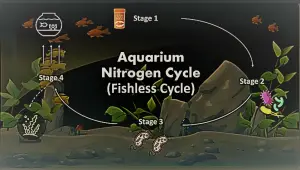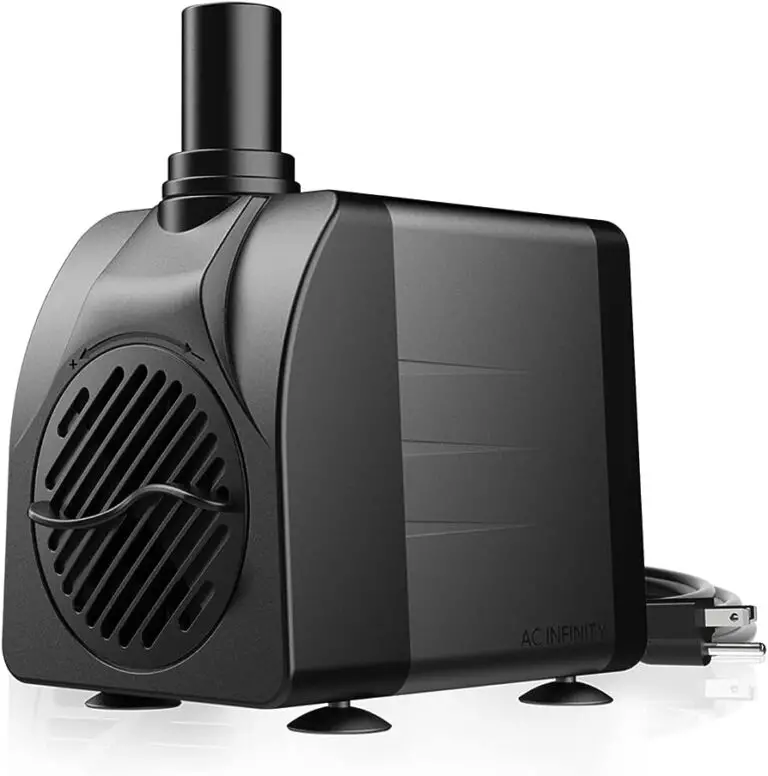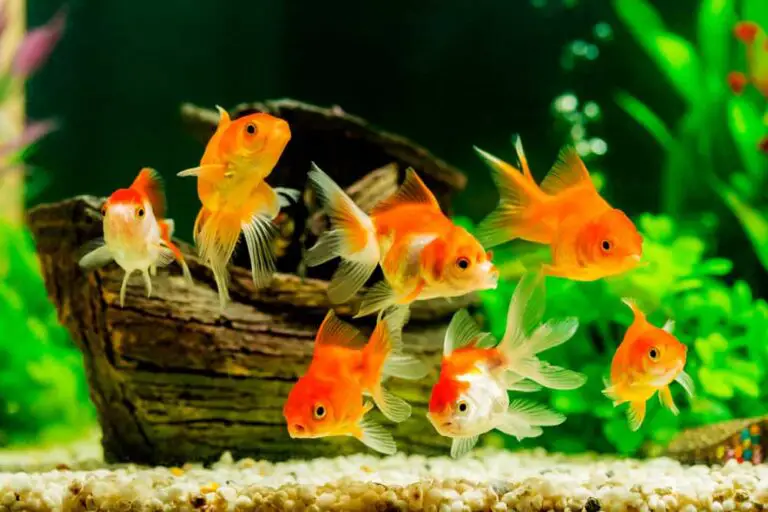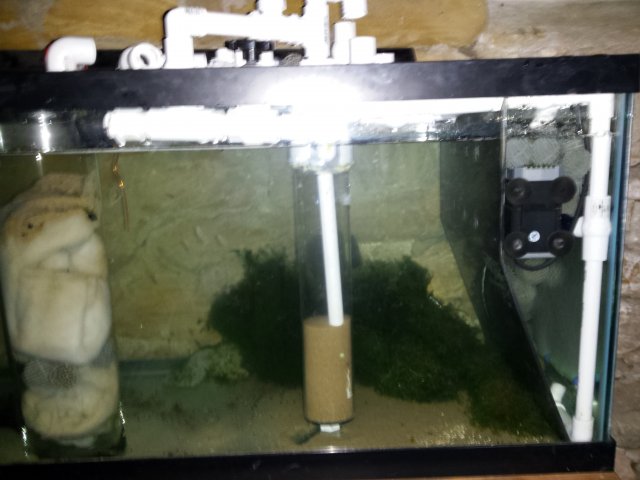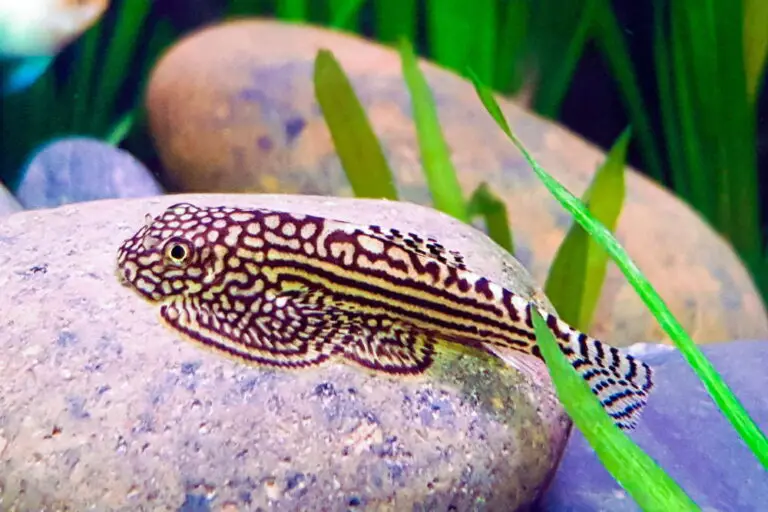Keeping A Healthy Aquarium Nitrogen Cycle And Why It’s Important
The aquarium nitrogen cycle essentially outlines how nature produces food (in the form of bacteria and plants), fish consume the food and generate garbage, and nature then recycles the trash.
You must verify that the water in your aquarium is clean and healthy before introducing any fish.
Too much food and decaying plant debris break down into ammonia and other toxins that harm fish.
Because an aquarium is ‘closed,’ waste builds up rapidly.
Unlike in a pond or river, there isn’t enough water to dilute or wash away hazardous substances.
As fishkeepers, we may utilize the ‘Nitrogen Cycle’ Once established in an aquarium, it transforms harmful waste.
See the picture below for further details.
Why is the nitrogen cycle important in aquariums?
The nitrogen cycle and why it is essential for fishkeepers:
You should be aware of how the water in your aquarium is kept clean and wholesome so that fish can dwell there before introducing any fish.
Unlike a pond or river, an aquarium is a closed water environment, so dirt and waste matter build up quickly.
Fish poop in their homes, and sometimes we add too much food, which sinks to the bottom.
In a fresh filter, the Nitrogen cycle takes time to develop.
‘Nitrifying’ microorganisms in the aquarium filter’s biological medium carry out the Nitrogen Cycle.
These bacteria need eight weeks to develop and increase the filter to Nitrogen Cycle levels.
During these early weeks, when there are few microorganisms, fish owners commonly endure fish fatalities caused by ‘New Tank Syndrome.’
How does the nitrogen cycle work in an aquarium?
The plants and the bacteria in the aquarium remove the ammonia and nitrite from the water through a process called nitrogen fixation.
This produces a chemical called nitrate.
The nitrate is then absorbed by the filtering system and absorbed by the plants as it is released into the water.
The nitrate is also depleted as food by the fish in the aquarium.
The plants use the nitrates in the water as a food source to grow.
How do I know when my tank has cycled?
Signs of a cycled tank: Your fish are alert, active, grow well and do not display any signs of stress.
You need to test your water to find out the levels of ammonia, nitrite, nitrate, and pH.
The nitrite and ammonia levels should be zero and the pH level should be close to 7.0.
If any of these levels are not zero, then the tank has not cycled yet.
When there are enough beneficial bacteria in the tank, then ammonia and nitrites should no longer be present.
The nitrates may still be present, but they will degrade over time.
If ammonia or nitrites are present, then the tank has not yet cycled.
Note that if you have a brand new tank or if it’s been a while since your tank was cleaned, it may take up to six weeks for the cycle to complete.
Does algae mean my tank is cycled?
Algae start an aquarium’s nitrogen cycle. This turns fish waste into nitrites and nitrates.
They indicate a cycled tank, but they’re not the sole indicator. Fish indicate a cycled tank.
They should eat, act, and seem healthy. More fish in your aquarium means more algae.
Fish excrement causes additional algae. Partial water changes may prevent algal development.
Too frequently will deplete good microorganisms. Algae indicates the tank has cycled.
It doesn’t imply the tank is cycled forever. The tank could get dirty or fall apart.
Knowing the nitrogen cycle is necessary before introducing fish.
For fish to live in the tank, the nitrogen cycle is very important.
A nitrogen cycle imbalance kills most tank fish. This pastime requires reading about the nitrogen cycle.
Algae doesn’t indicate a healthy tank. Algae growth indicates instability.
Algae also suggests that you have too much light, which plants don’t appreciate.
Overfeeding causes algae. Algae growth indicates excess CO2.
How does nitrogen cycle in aquariums?
An aquarium can be cycled in two ways. First, and most naturally, you can just wait it out.
Some people buy used tanks, but they are expensive.
The second option is to add bacteria from another aquarium.
Get some filter media from a friend or family member who has an aquarium.
If you don’t know anyone, you can buy a bottle of “live sand,” which contains bacteria that grows naturally in the sand.
Insert it into the filter. A bottle of bacteria is another filter medium you can use.
Insert it into the filter. This method is much quicker because the bacteria are more concentrated.
The nitrogen cycle is complicated. To begin, what is the nitrogen cycle?
The nitrogen cycle shows how nitrogen goes from being bioavailable to being biounavailable.
This cycle is made up mainly of ammonia, nitrites, and nitrates.
Ammonia is the form of nitrogen that animals, plants, and bacteria use.
In large amounts, it is harmful to fish. At low levels, it helps plants grow.
Nitrites are made when ammonia breaks down and are harmful to fish, plants, and bacteria.
Nitrites break down into nitrates, which are harmful to plants and bacteria.
Aquarium nitrogen cycle diagram
Cycle chart
Aquarium nitrogen cycle steps
Nitrogen is transformed throughout the nitrogen cycle into a form that aquatic plants and animals can use.
The cycle consists of these five major steps:
1) Bacteria turn nitrogen into ammonia.
2) Ammonia is converted to nitrite by another bacteria.
3) Nitrite is converted to nitrate by yet another bacteria.
4) A special type of bacteria is required to convert the nitrate to nitrogen gas, which is released into the air.
5) Finally, the nitrogen gas is converted to nitrate by yet another bacteria.
Aquarium nitrogen cycle ph
saltwater tanks: ph: 8.2-8.4 ammonia: 0 nitrite: 0 nitrate: less than 40
freshwater tanks: ph: 7.2-7.8 ammonia: 0 nitrite: 0 nitrate: 10-20
Fishless cycling with live plants
The technique of cycling a new aquarium without utilizing fish is known as fishless cycling.
This can be done by using live plants, which will help to remove ammonia and nitrites from the water.
The bacteria required to break down the ammonia and nitrites will also get oxygen from the plants.
The process can take several weeks, but it is a safe way to cycle a new aquarium without putting any fish at risk.
Fishless cycling with live plants is a process by which you can establish a healthy aquarium without using fish.
This method uses plants to help remove ammonia and nitrites from the water, making it safe for other creatures.
The process can take a few weeks, but it is well worth the effort to create a safe and healthy environment for your future fish friends.
Fishless nitrogen cycle
Fishless nitrogen cycle is the process in which the nitrifying bacteria grow in the aquarium with no fish present.
It is a process which is almost similar to the natural cycle and has been done by many aquarists before aquascapers.
It is the ideal process for keeping tanks for sensitive species like Discus who are not able to handle high ammonia levels.
In this process, the aquarium is quickly filled full of water with the fish present and is then left for a day or two.
This helps in removing the nitrogen from the fish waste and then the fish are removed from the tank.
Then the tank is isolated from the rest of the aquarium and the water is treated with ammonia.
Then after 24-48 hours, nitrifiers grow and take care of the ammonia and convert it into nitrite.
After another 24-48 hours, nitrifiers convert nitrite into nitrate.
You may put the fish back in the aquarium when this procedure is properly finished.
This process is also best for the planted aquarium.
Because the ammonia feeding bacteria help in keeping the water up to the optimal level for plant growth.
Freshwater nitrogen cycle
The freshwater nitrogen cycle is not a separate cycle but part of the overall nitrogen cycle.
The freshwater portion of the nitrogen cycle involves the conversion of nitrate (NO 3 –) to nitrite (NO 2 –) and then to ammonia (NH 4 +).
Nitrate is converted to nitrite by the bacterial action in the sediments of water bodies.
The nitrite may be used by the nitrifying prokaryotes (organisms with no nucleus) or may be oxidized to nitrate by the aerobic prokaryotes (organisms with a seat).
Living organisms use ammonia to make cellular proteins.
The nitrate-reducing prokaryotes (organisms with a heart) convert the nitrite to nitrate.
Plants and other creatures in the water body utilize the nitrate after that.
The freshwater nitrogen (nitrification) cycle is an anoxic, anaerobic process that converts ammonia to nitrite and nitrite to nitrate.
Ammonia is initially oxidized by the action of ammonia-oxidizing archaea, which are prokaryotic organisms.
These archaea are a group of prokaryotes organisms, meaning that they have no membrane-bound nucleus but do contain ribosomes.
In step one of the cycle, ammonia is oxidized by the archaea to nitrite plus nitric oxide.
Step two is where the nitrite, oxygen, and hydrogen sulfide are oxidized to produce more nitrite and nitrate.

